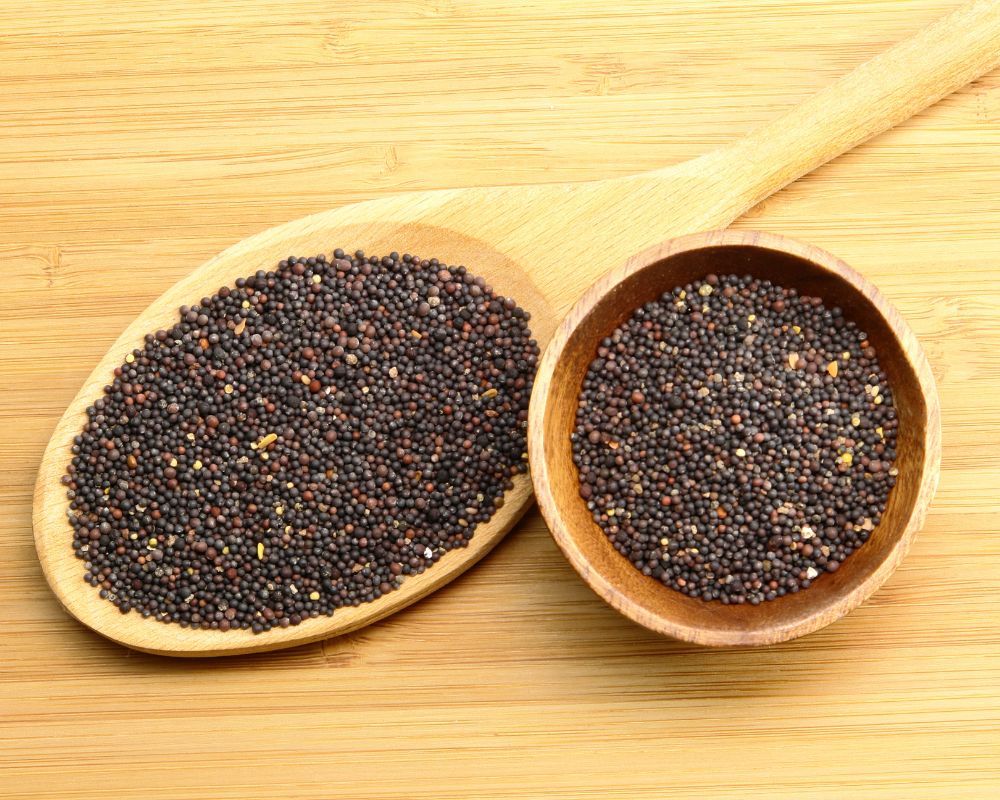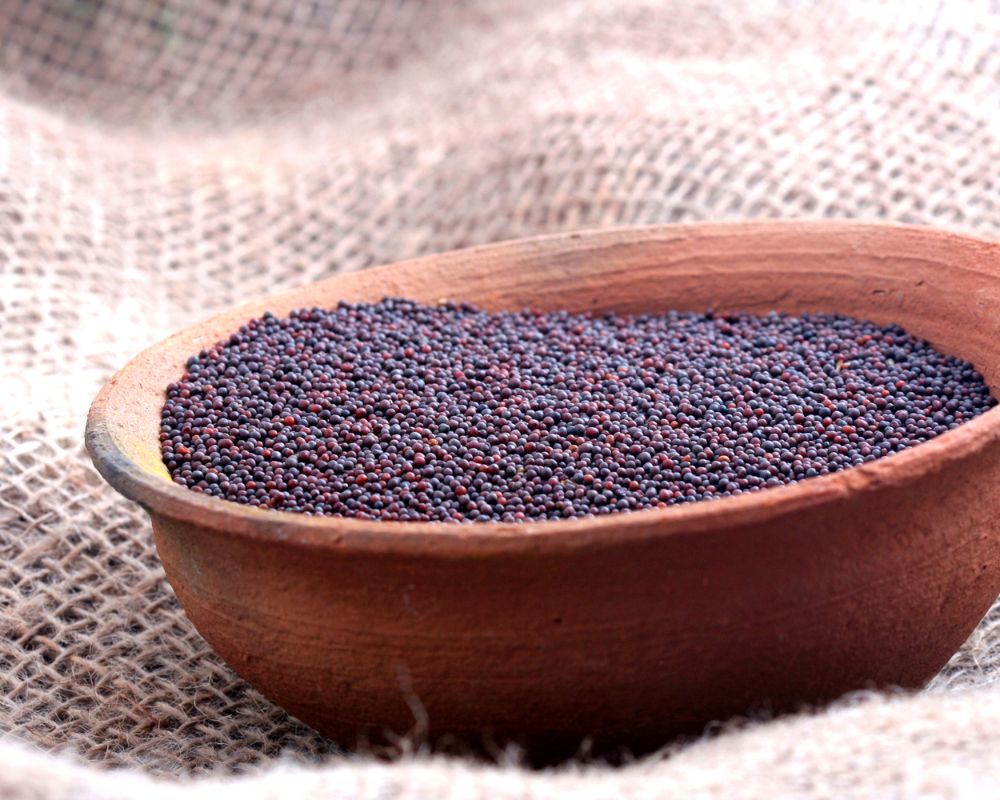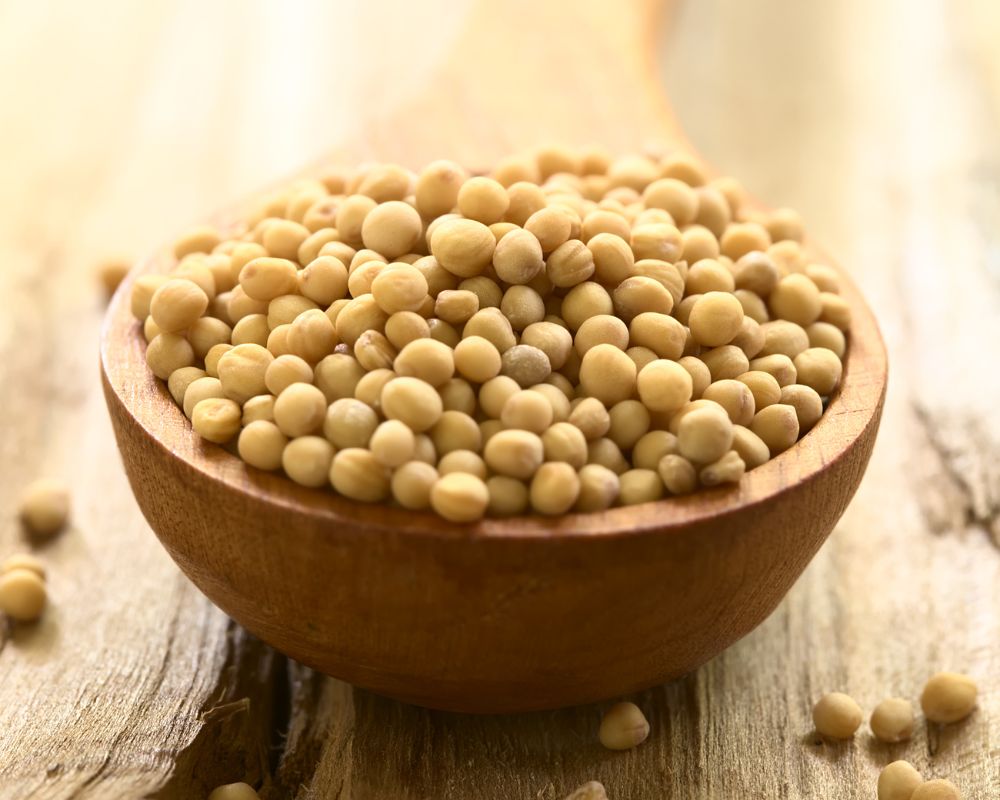Black mustard seeds (Brassica nigra) are a tiny and round whole spice with a dark brown to black color, and they come from the same family as horseradish. They are commonly used in Bangladeshi, Pakistani, and Indian cooking to add flavor and aroma to dishes and are a popular Indian spice, just like cardamom and cumin.
Table of Contents
What are black mustard seeds?

Black mustard seeds are small, round, and dark seeds from the mustard plant. They are a common spice in India, Pakistan, and Bangladesh.
| Origin | Likely the Mediterranean |
| Appearance | Have a rough, textured surface |
| Flavor profile | Sharp taste, slightly bitter |
| Dishes | Aloo Gobi, Baingan Bharta, Chana Masala |
Origin
The mustard plant could have originated in the Mediterranean but is now grown worldwide. Black mustard seeds are particularly popular in South Asian cuisine, where they go into various dishes, such as curries, pickles, stews, soups, and chutneys.
Appearance
Black mustard seeds have a rough, textured surface and are typically sold whole. However, they can also be ground into a paste, often used as a condiment.
Flavor profile
Black mustard seeds have a zing and a sharp, slightly bitter taste. When used in cooking, they add a depth of flavor and a bit of heat to dishes. They pair well with other spices like paprika and black sesame seeds.
Dishes
One popular recipe that uses black mustard seeds is Aloo Gobi, a vegetarian dish made with potatoes and cauliflower.
The recipe involves sautéing black mustard seeds in oil with other spices before adding the vegetables and cooking them until tender. The mustard seeds also add a delicious pungency to Baingan Bharta and Chana Masala.
Nutritional Benefits of black mustard seeds
Mustard seeds have many essential minerals that can provide health benefits.
The leaves and seeds of mustard are rich in vitamins A, C, and K, which can help fight chronic diseases, improve eyesight, and aid in blood clotting. Mustard seeds are also a good source of:
- Magnesium
- Manganese
- Selenium
In addition, the isothiocyanates and sinigrin, along with isorhamnetin, kaempferol, and carotenoids, can protect against infections, oxidative damage, inflammation, bacteria, and various chronic diseases.
While mustard seeds are generally safe to eat, some people may experience issues like indigestion or nausea if they consume a lot.
black mustard seeds vs. yellow mustard seeds: comparison


Black and yellow mustard seeds are two different varieties of mustard seeds with distinct differences in flavor profile, appearance, and culinary uses. Here’s a brief comparison:
| Black Mustard Seeds | Yellow Mustard Seeds | |
| Flavor Profile | An intense, sharp, and spicy flavor with a hint of sweetness | A milder and slightly sweet taste with a bit of heat |
| Appearance | Smaller than yellow mustard seeds, dark brown or black | Pale yellow, with a smooth outer surface |
| Culinary Uses | Common in Indian cuisine for tempering, pickling, and spice blends | American cuisine, used in pickling liquids, salad dressings, and marinades |
Some dishes that use black mustard seeds include:
- Aloo Gobi (Indian cauliflower and potato dish)
- Baingan Bharta (Indian eggplant dish)
- Chana Masala (Indian chickpea curry)
Some dishes that use yellow mustard seeds include:
- Classic yellow mustard
- Honey mustard dressing
- Dijon mustard sauce
What are black mustard seeds used for?
Here are some exciting recipes that call for black mustard seeds:
- Achari Chicken: This is a popular Indian dish made with chicken marinated in spices, including black mustard seeds, cumin, fennel, kalonji, and fenugreek.
- Roast Beef with Horseradish and Mustard: Since mustard and horseradish are part of the same family, you can pair them up. This recipe involves rubbing a beef roast with a delicious mixture of mustard seeds, bacon, butter, cloves, horseradish, and other spices before roasting it in the oven.
- Black Mustard Seed Nut Brittle: This is the perfect combination of sweet and savory. The crunch of the nuts and the zing of the mustard seeds is just perfect.
- Shrimp With Chilies and Mustard Seeds: The chilies and mustard seeds give the shrimp a spicy kick that will have you reaching for a glass of water.
- Roasted Red Lentil Soup with Black Mustard Seed: The black mustard seeds add a subtle but delightful flavor to the earthy lentils. Plus, it’s hearty enough to satisfy any appetite.
Frequently asked questions
What can be used instead of black mustard seeds?
White mustard seeds, yellow mustard seeds, or brown mustard seeds can be used instead of black mustard seeds in recipes. Additionally, the mustard powder can work as a substitute.
Can you eat black mustard seeds?
Black mustard seeds are safe to eat. However, they are used in cooking and not consumed raw or alone. Note that mustard seeds should be used in moderation as they can be intense and spicy.
Consuming large quantities of mustard seeds or their derivatives can cause stomach upset or other digestive issues.
Which is better, yellow or black mustard seeds?
Yellow mustard seeds have a milder flavor than black mustard seeds, which have a more intense flavor. The choice between yellow and black mustard seeds would depend on the desired flavor profile for a particular dish.
Do black mustard seeds taste like mustard?
Yes, black mustard seeds have an intense, slightly bitter flavor similar to the taste of mustard.
What are the side effects of black mustard seeds?
Eating black mustard seeds in moderation is generally safe for most people. However, consuming large amounts of black mustard seeds may cause digestive issues such as bloating, gas, and diarrhea.
Is it safe to eat raw mustard seeds?
While consuming mustard seeds in moderation is generally safe, you should not eat raw mustard seeds. Raw mustard seeds can be difficult to digest and may cause gastrointestinal issues.

